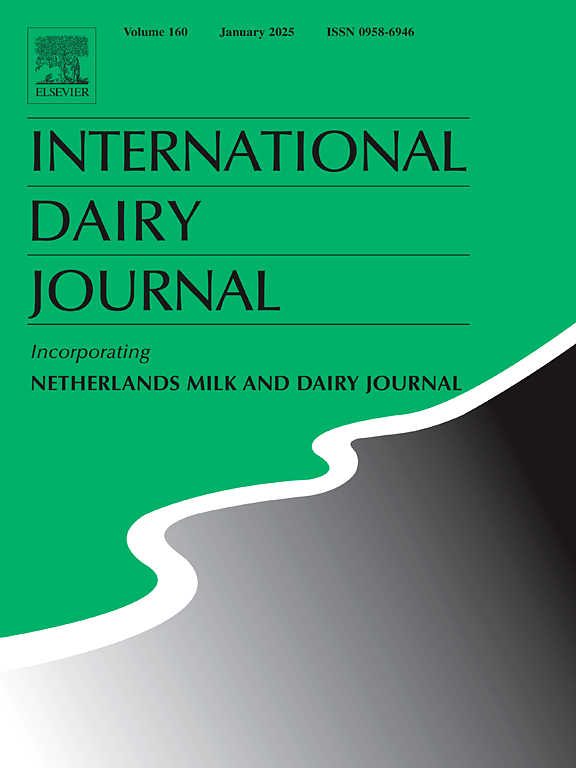MALDI-TOF mass spectrometry analysis of seasonal variations in culturable milk microbiota and physico-chemical properties in Poland: Implications for dairy management and quality control
IF 3.4
3区 农林科学
Q2 FOOD SCIENCE & TECHNOLOGY
引用次数: 0
Abstract
The primary objective of this study was to systematically examine the seasonal fluctuations within the milk microbiome with the use of MALDI-TOF-MS technique. Moreover, the quality of milk was evaluated based on the basic milk parameters such as total protein and fat content, titratable acidity (SH), pH, density, total bacteria count, and somatic cell count (SCC). The results revealed significant seasonal variations in both the microbial composition and the physico-chemical properties of milk. Spring exhibited the highest microbial diversity, while autumn showed the lowest. Dominant bacterial genera included Staphylococcus, Corynebacterium, Aerococcus, and Bacillus, with specific genera such as Brevundimonas appearing exclusively in spring and Jeotgalicoccus in summer. Physico-chemical analysis indicated that milk fat and protein content were highest in winter and lowest in summer, correlating with changes in photoperiod and heat stress effects on cows. The highest bacterial counts and somatic cell numbers were observed in summer and autumn, corresponding with increased incidences of mastitis. These findings underscore the importance of monitoring seasonal changes to ensure milk quality and safety, suggesting that targeted management practices could mitigate the seasonal impact on milk production. The research sheds light on the influence of seasonal dynamics on the milk microbiome and its quality indicators, offering crucial information to advance dairy management strategies and ensure superior product quality control.
MALDI-TOF质谱分析波兰可培养牛奶微生物群和理化性质的季节性变化:对乳制品管理和质量控制的影响
本研究的主要目的是利用 MALDI-TOF-MS 技术系统地检测牛奶微生物群的季节性波动。此外,还根据总蛋白质和脂肪含量、滴定酸度(SH)、pH 值、密度、细菌总数和体细胞数(SCC)等牛奶基本参数对牛奶质量进行了评估。结果显示,牛奶的微生物组成和理化特性都存在明显的季节性变化。春季的微生物多样性最高,而秋季最低。主要细菌属包括葡萄球菌、棒状杆菌、气球菌和芽孢杆菌,特殊属如 Brevundimonas 只出现在春季,而 Jeotgalicoccus 则出现在夏季。理化分析表明,牛奶中的脂肪和蛋白质含量在冬季最高,夏季最低,这与光周期的变化和热应激对奶牛的影响有关。细菌计数和体细胞数在夏季和秋季最高,这与乳腺炎发病率增加有关。这些发现强调了监测季节变化以确保牛奶质量和安全的重要性,表明有针对性的管理措施可以减轻季节对牛奶生产的影响。这项研究揭示了季节动态对牛奶微生物组及其质量指标的影响,为推进乳业管理策略和确保卓越的产品质量控制提供了重要信息。
本文章由计算机程序翻译,如有差异,请以英文原文为准。
求助全文
约1分钟内获得全文
求助全文
来源期刊

International Dairy Journal
工程技术-食品科技
CiteScore
6.50
自引率
9.70%
发文量
200
审稿时长
49 days
期刊介绍:
The International Dairy Journal publishes significant advancements in dairy science and technology in the form of research articles and critical reviews that are of relevance to the broader international dairy community. Within this scope, research on the science and technology of milk and dairy products and the nutritional and health aspects of dairy foods are included; the journal pays particular attention to applied research and its interface with the dairy industry.
The journal''s coverage includes the following, where directly applicable to dairy science and technology:
• Chemistry and physico-chemical properties of milk constituents
• Microbiology, food safety, enzymology, biotechnology
• Processing and engineering
• Emulsion science, food structure, and texture
• Raw material quality and effect on relevant products
• Flavour and off-flavour development
• Technological functionality and applications of dairy ingredients
• Sensory and consumer sciences
• Nutrition and substantiation of human health implications of milk components or dairy products
International Dairy Journal does not publish papers related to milk production, animal health and other aspects of on-farm milk production unless there is a clear relationship to dairy technology, human health or final product quality.
 求助内容:
求助内容: 应助结果提醒方式:
应助结果提醒方式:


